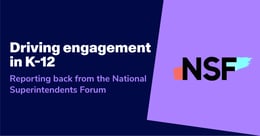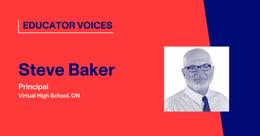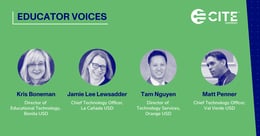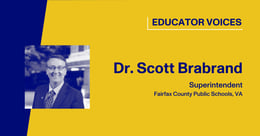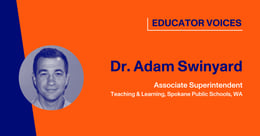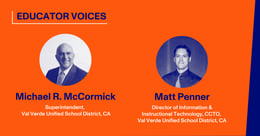This interview, edited for clarity and length, is part of a series with educational leaders to highlight their perspectives on the changing realities of education.

Uprooting and Cultivating Growth: Dr. Tina Powell’s Mission to Accelerate and Change
5 Questions with Dr. Tina Powell
Recently promoted to a new role where she will be tasked with restructuring and reprioritizing how Orange Public Schools operates, Dr. Tina Powell knows there will be challenges ahead. After a storied career leading up to this opportunity, she has a vision for what needs to be done, but enacting it with buy-in from her community will take time. But, in the face of unfinished learning from the previous year, now is the time to make strides in both how instructional and non-instructional systems function for students, teachers, and the community as a whole.
Congratulations on your new role! Can you share what your focus is as Assistant Superintendent of Innovations and Systems?
The main priority of my role is to find the natural connections between instructional and non-instructional priorities. I help schools to think creatively and see where they can improve their systems to better serve their students and teachers. We know that something as seemingly non-instructional as a school schedule or district-wide calendar, for example, can support the curricular and instructional world. When we strategically planned with the executive directors, a common conversation across all the different offices was the importance of a school schedule and how a lot of our curricular programs are impacted by the school schedule. For example, if a school is making sure that the math, English, social studies, and science teachers each have their time to plan their respective classes with peers while the students are in a gym, music, or art class, it almost deems the art and the music teachers as 'coverage', as opposed to only instructional anchors in their own right. Therefore, my types of conversations are around how we can give the core subject teachers their time to plan, but at the same time, make sure we have healthy, vigorous, and vibrant programs of art, music, and gym where the teachers are not just covering classes, but they're actually affecting their own programs.
Who specifically do you work with to make these decisions and changes?
Most of these “change conversations” or strategic thinking sessions happen or need to happen during summer break while the students are off. During that time, however, most of the teachers and principals are also on vacation. So we tend to have these conversations at the central office level with the executive directors. My role in these discussions isn’t to create a detailed plan with them, but rather to act as a sounding board by pushing the questions that start the strategic thinking. I help design a skeleton or an outline of a plan with the executive directors by uncovering and establishing their priorities, and then we build it up from there. The hope is that they can then create an outline of their own that fits their unique situation and bring it to their individual schools and teachers to collaborate and create a strategic plan to not only build a robust schedule for their students but to also add more quality to their schedules.
What do you think your biggest challenge will be?
It’s inevitable that we will face challenges as we uproot a system and way of doing things. But we also know that sometimes, in order to fix something, you need to break it first. I believe that will be the case for a lot of future changes and improvements. As we uproot the current structures, systems, and schedules we can redesign them in a way where there's a focus on the system versus the entity itself. For example, when we're designing a high school schedule, we’re not just looking at scheduling time, people, and places, but the idea of scheduling a full-bodied curricular program. But that doesn’t happen unless we interrupt the way things are operating, which always comes with unique challenges.
What is your district doing to tackle the need for learning acceleration?
Schools usually deal with some degree of learning loss each year as students come back from summer break. The learning that they accumulated from the previous year will naturally regress a bit. With COVID, however, we’re seeing something I call “unfinished learning”, as opposed to learning loss. Students didn’t necessarily lose face-to-face learning with their teachers but experienced a diminished learning opportunity. For example, technical subjects like math and science require hands-on engagement and typically need math tools like rulers, compasses, and protractors or they need to interact in lab settings. When we went into remote & virtual learning, we lost that tangible experience in most cases. So, with that said, this idea of unfinished learning encourages me, as the Assistant Superintendent of Innovations and Systems, to focus more of my conversations around acceleration.
A few years ago, I wanted to see what learning acceleration looked like with special education students in self-contained settings. I mapped out the curriculum that put those students on a progression towards grade-level content. So, for example, let's say a student is two grade levels below. What I did was tie together all of the skills that would accelerate them two grade levels forward. Meaning, if this student was in sixth grade, but he or she needed some fourth-grade content, I would map the fourth and fifth-grade content that he or she would need to gain a firm understanding of the sixth-grade content. So, within a year's time, the student would be able to touch on these different concepts that will lead him or her to the current grade-level appropriate content. The last time I gathered data on this process was pre-COVID, and we saw that, of those students, 67% grew one full grade level. Therefore, I’m confident that this learning acceleration strategy can work all across the board, including the students who are in more severe settings.
Are you looking to make any changes or include new programs to support extended learning?
We’re absolutely looking to provide additional resources that we may not have considered in the past. We are seeing a variety of reasons why a student might need the support of extended learning, especially coming into a new year since COVID first hit. For example, a parent might be looking to bring their child back up to grade level, or perhaps the SATs are coming up. So, how do we achieve this goal? The first step is to look at what happens during the school day in terms of instruction. After that, the natural next step is to enroll the student in outside intervention, i.e. tutoring. If we have a large student population, however, in which a typical 35% of students need additional intervention, it is difficult to support all of these students if the only option is in-person tutoring.
In terms of trying to develop a district strategy, I've been looking at ways in which we can incorporate lessons learned from COVID. One positive thing that came out of COVID is that most, if not all, of the students, are now able to use technology and virtual settings to engage in instruction. If a student needs ancillary support, they not only have that opportunity to seek tutoring in-person but can also use outside intervention like Paper to help them better understand a particular subject. If we can combine strong, in-person instruction and a robust, online tutoring platform that can target a student’s specific academic needs, then I am confident that students will be able to reach their goals.

